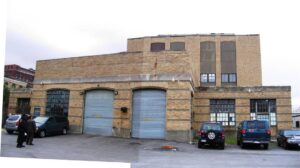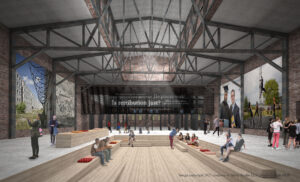
On the South end of Ossining’s Louis Engel Riverfront Park, a fence separates a playground from the grounds of Sing Sing Prison. Many visitors are unaware the prison is there, even though a disused guard tower sits among the swing sets.
The Sing Sing Prison Museum, slated to open to the public on the institution’s 200th anniversary in 2025, hopes to shine a spotlight on its legacy and the future of incarceration.
As far back as the 1980s, plans were made to build a museum on the grounds of Sing Sing. In 2007, Westchester County conducted a series of environmental, economic, and tourism studies which served as a blueprint for the concept, but progress was hindered by the recession of 2008.
In 2014, Assemblywoman Sandy Galef secured state funding for the project, which was spearheaded by Historic Hudson River Towns. A year later Brent Glass, a former director of the Smithsonian National Museum of American History, was brought on to lead the program.

The museum will be located mainly in a building at the prison’s north end known as the “powerhouse,” which was once home to the coal-fueled turbines which powered the prison and now serves as a garage and staff locker rooms.
“We want to transform this powerhouse into a powerhouse of education, ideas, and creativity,” says Glass.
The museum will also feature a covered walkway leading to the remains of the original Sing Sing cellblock constructed in 1825, where prisoners resided in 3.5’ x 7’ cells.
According to Glass, the story of Sing Sing Prison can be told in five chapters:
- The River – The Hudson River carried the first group of prisoners to Sing Sing from Auburn State Prison near Syracuse in 1825, as well as many of its future residents “up the river” from the New York City area. It has also provided a bucolic backdrop to the prison’s often harsh conditions over the years.
- The Rock – Sing Sing means “stone upon stone” in the Mohegan Indian language. The site was home to a rich limestone deposit which provided not only the materials with which to build the prison, but also a source of income for the institution by providing building stone for projects in New York City, Albany, and Troy.
- The Railroad – Many of the area’s railroads were built using limestone from Sing Sing’s quarry, and transported goods produced by the inmates there, including cast iron stoves.
- The Ruin – The original cellblock began to deteriorate rapidly in the beginning of the 20th century, prompting visiting Sherlock Holmes author Arthur Conan Doyle to suggest it be torn down immediately. Governor Charles Seymour Whitman announced its closing in 1917, but the last prisoner was not relocated until 1943.
- Reform – Sing Sing Prison employed 19th century prison reformers Eliza Farnham and Thomas Mott Osborn, and is a place where conversations on reform continue to this day.
Addressing issues of prison reform and mass incarceration will be a priority for the museum, says Glass.
“The core question that we want people to think about is, why do we have prisons?” he says. “We want to look at that from a historical standpoint and with reference to contemporary issues.”
Glass points out that the current situation at Riker’s Island in New York City shows that these conversations remain as relevant as ever.

Part of Sing Sing’s legacy is its role in capital punishment. It was the central location for executions from 1891 to 1963, and its electric chair claimed the lives of 614 prisoners including accused spies Julius and Ethel Rosenberg and serial killer Albert Fish.
In addition to exhibits on Sing Sing’s portrayal in film, the role of sports on rehabilitation (the New York Yankees played an exhibition game there in 1929), and the prison’s famous residents, the museum hopes to host theatrical performances and provide resources for re-entry counseling and youth mentoring.

“We don’t want this to purely just be a stale place where you just go and see stuff on the walls – we really see Sing Sing Prison Museum as a true model of integration of dialogue, history, humanities, and art,” says Assistant Director Nicole Belle DeRise. “A place where we can have really tough discussions and think about all of these incredibly complex issues around social justice and criminal justice.”
One of the biggest reasons the project has gained so much momentum in the past few years, Glass says, is because of the enthusiasm and hard work of the team behind it.
“We have a very passionate and dedicated board of trustees,” says Glass. “These are people who have given their time, talent, and treasure to make sure this museum actually happens.”
One key member of the team is Sing Sing’s official historian and photographer Arthur Wolpinsky, who has worked at the prison since 1971.
The next step in the Sing Sing Prison Museum’s ambitious plan is to secure a lease for the property from the state, at which point the organizers can access state funding and begin construction. DeRise looks forward to sharing the diverse and often unheard stories of Sing Sing with the public.
“Our mission is to tell the compelling – but also very complex – stories of Sing Sing,” she says. “And to do it in a respectful way that is people forward, ensuring that we are humanizing every aspect of this and honoring both people who are victims of crime and people who are incarcerated.”








A couple of obvious questions not addressed: is the prison still in operation and if so how such a project would be palatable; will the electric chair (“old sparky” I believe was its nickname) be exhibited/does it still exist??